
Spring Cleaning & Falling in Love – AGAIN
Explore a journey through nostalgia as spring cleaning unveils forgotten treasures from a lifetime in the world of dogs. Memories await!

Home » Dog Breeds » English Springer Spaniel Dog Breed
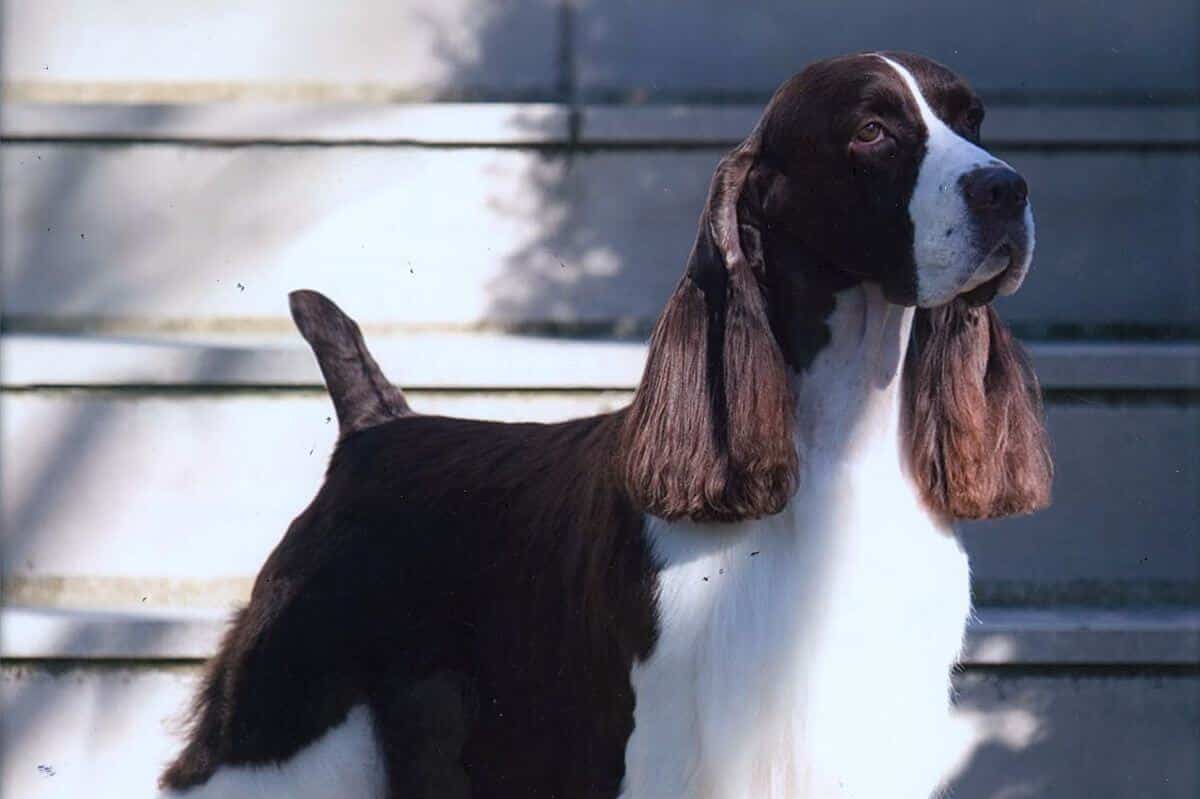

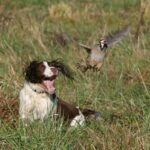
The English Springer Spaniel is renowned for its agility, intelligence, and affable demeanor. Traditionally used as a working gundog, this outgoing and attractive breed has since won the hearts of many as a beloved family companion. With an eager-to-please personality and a love for outdoor activities, the “Springer” has continued to gain popularity among hunting enthusiasts and urban dwellers alike.
Sporting
19 – 20 Inches
40 – 50 Pounds
12 – 14 Years
| Country of Origin | England |
|---|---|
| Bred For | Flushing & Retrieving Birds, Companionship |
| Known For | Gentle Expression, Long Ears, Wagging Tail, Friendliness |
| Popularity | High |
| Temperament | Active, Friendly, Playful, Outgoing |
| Activities | Hunting, Running, Hiking, Swimming, Search and Rescue, Conformation Shows, Dog Sports |
The English Springer Spaniel boasts a rich history that stretches back to the 19th century and the advent of dog shows and field trials. Known for its exceptional flushing and retrieving skills, the breed’s origins are deeply rooted in the British Isles.
The name “spaniel” is believed to have derived from the Spanish word “Espanol,” indicating that these dogs could have a Spanish connection. However, it was in England that they were refined and developed into the breeds that are recognized today. Historical records, including art and literature from the Renaissance, depict dogs that closely resemble today’s English Springer Spaniel.
During the 17th and 18th centuries, spaniels in England were primarily categorized based on their size and hunting functions. The larger ones, adept at flushing game out of dense vegetation, were termed “springers” because of their ability to “spring” game for the falcon or nets. As individual breeds began to emerge, selective breeding started to focus on specific traits, leading to the distinction between the English Springer Spaniel and its close cousins, the Field and Cocker Spaniels.
The late 19th and early 20th centuries marked significant milestones for the Springer. In 1902, The Royal Kennel Club in the UK distinguished it as a separate breed. Recognition soon crossed the Atlantic, with the American Kennel Club (AKC) officially acknowledging the breed in 1910.
Through subsequent years, in both the field and in the show ring, the Springer has garnered considerable acclaim. The breeds’ versatility and endearing temperament have solidified its reputation as both a exceptional gun dogs and an extraordinary show dog.
Today, the English Springer Spaniel enjoys widespread admiration, reflecting its innate abilities and its outgoing disposition. Whether in a show ring, a suburban backyard, or a country estate, the breed’s legacy lives on.
Adult male English Springer Spaniels ideally stand 20 inches tall at the shoulder, while mature females tend to be slightly smaller, measuring around 19 inches in height.
In terms of weight, males average about 50 pounds, with females weighing closer to 40 pounds.
The English Springer Spaniel presents a balanced and useful form. Medium-sized and sturdy, this breed is robust without appearing bulky. In profile, the Springer’s back is level from the withers to a slightly sloping croup. The body, when measured from the shoulder to the buttocks, is a bit longer than the dog’s height at the withers. This proportionality ensures the breed’s agility and fluid movement, reflective of its working origins as a top-flight bird dog.
Texture: The English Springer Spaniel boasts a double coat that provides insulation and protection on land and in water. It is medium in length, flat or wavy, and lies close to the body. Its texture is neither too coarse nor too silky. The hair is short and fine on the head, on the front of the forelegs, and on the front of the rear legs below the hocks. The ears, chest, belly, and legs are feathered with longer fringe. The coat is typically trimmed, but it should not be excessively stylized.
| Standard Color | |
|---|---|
| Black & White | ee |
| Black White & Tan | ee |
| Liver & White | ee |
| Liver White & Tan | ee |
| White & Liver | ee |
| White & Black | ee |
| Red & White | ee |
| Orange & White | ee |
| Lemon & White | ee |
| Standard Marking | |
|---|---|
| Ticked | ee |
| Spotted | ee |
| Roan | ee |
A Note About Color: Color may be black or liver with white markings; white with black or liver markings; blue or liver roan; or tricolor (black and white or liver and white with tan markings on the eyebrows and cheeks, inside the ears, and under the tail). Any areas of white may present ticking or spots. Red, Orange, and lemon are not acceptable colors in this spaniel breed.
The tail of the English Springer Spaniel is an embodiment of the breed’s lively spirit and eager character. It is set as an extension of the topline and is typically docked to prevent injury while working in thick brush. When the Springer is in motion, especially when working, the tail is carried horizontally, wagging rhythmically with each stride. The tail should not be carried upright or curled forwards, nor should it be clamped down tightly.
Contemporary views on tail docking vary, so it’s essential for owners of this breed to be aware of local regulations regarding the practice.
Whether docked or undocked, the Springer’s tail always exhibits the breed’s characteristic enthusiasm and exuberance, especially when these sporting spaniels are on the move or particularly excited.
Owning an English Springer Spaniel can be a delightful experience. Renowned for its cheerful disposition and boundless energy, these dogs bring joy to any household and easily fit it in as loyal companions. However, as with any dog, potential owners should be well-informed about the breed’s characteristics, needs, and potential challenges.
The English Springer Spaniel, when well cared for, is generally a healthy and robust breed. However, like all breeds and mixed breeds, they can be prone to certain health conditions. It is crucial for owners to be proactive in their pet’s health, maintaining a regular veterinary schedule and being observant of any behavioral or physical changes.
Lifespan: On average, a well-cared-for Springer can live between 12 and 14 years, although many have been known to surpass this with proper care, lots of love, and a bit of luck.
The English Springer Spaniel, like any dog, can have its share of health concerns. These include:
It is essential for English Springer Spaniel owners to have regular veterinary check-ups, ideally twice a year. These routine visits allow early detection of potential issues, ensuring timely treatment.
The English Springer Spaniel boasts a temperament that’s often described as affable and eager to please. The breed’s cheerful disposition allows these dogs to form strong bonds with their families and thrive on human interaction. These traits make them a suitable choice for first-time dog owners, as they’re accommodating and tend to respond positively to gentle guidance and training. Their sensitivity means they resonate best with positive reinforcement training methods; harsh treatment or scolding can potentially lead them to become timid and mistrustful.
Although they cherish their independence to a certain degree, Springers are not fans of solitude. Extended periods of being alone can trigger feelings of separation anxiety. As such, potential owners should be prepared to offer them consistent companionship or at least ensure they aren’t left isolated for long durations.
Socially, they typically get along splendidly with their canine counterparts. With proper socialization from a young age, most Springers become quite overjoyed around other dogs. Their gentle and playful demeanor also makes them ideal companions for children. However, as with any breed, interactions between dogs and young kids should always be supervised to guarantee the safety of both parties.
The English Springer Spaniel’s warm nature usually extends to strangers as well. While these dogs might approach unfamiliar faces with a hint of caution initially, with proper introductions, they’re often welcoming and friendly to the people they meet. In essence, the Springer, with its delightful personality and adaptable nature, can integrate smoothly into a variety of households, offering affection and joy in abundance.
The dietary needs and nutritional habits of the English Springer Spaniel play a pivotal role in ensuring the dog’s well-being and vitality. These dynamic canines require a balanced diet that complements their energy levels and supports their overall health.
For Springer Spaniel puppies, it’s essential to provide them with a high-quality puppy formula that meets the unique nutritional requirements of their growth phase. Puppies can grow rapidly, so their diet should account for their developing muscles, bones, and overall health. The portion size and feeding frequency can vary based on age, but generally, puppies are fed more often than adults to support their growth — typically three to four times a day.
Transitioning into adulthood, the nutritional needs of the Springer will change. Adult dogs require a balanced diet that offers a mix of proteins, fats, and essential vitamins and minerals. Proteins help to maintain muscle tone, while fats provide the necessary energy. The amount of food required can vary based on the dog’s activity level, age, and overall health. On average, an adult Springer Spaniel might consume between 1.5 to 2.5 cups of high-quality dog food daily, split into two meals. However, always consult a veterinarian or a pet nutritionist to determine the exact portion size suitable for the specific dog.
Overfeeding or underfeeding can have adverse effects on the health and longevity of an English Springer Spaniel. Monitoring their weight, ensuring they have a consistent feeding schedule, and adjusting portion sizes based on activity levels can contribute to the dog’s overall health and happiness.
English Springer Spaniels are renowned for their intelligence and willingness to please, traits that make them relatively straightforward to train. Their history as hunting dogs means they’re hardwired to respond well to tasks and commands, although their gentle nature means positive reinforcement methods work best.
Training should begin early, ideally during puppyhood. Socialization is a crucial component of any puppy’s training regime. Exposing Springer pups to various environments, people, and other animals helps to foster well-adjusted adult dogs that are comfortable in diverse settings. While they are generally eager to please their owners, it’s essential to maintain consistency in training sessions to reinforce learned behaviors and to prevent the development of unwanted habits.
Given the Springer’s intelligence, the breed has a moderate tendency to bark, especially if the dog senses something amiss or if it gets bored. Regular training and mental stimulation can help to manage this trait. The curious nature of this breed, paired with its bird dog background, means these dogs might occasionally exhibit a potential for wanderlust. It’s wise to be sure they’re always in a secure area or on a leash during outdoor excursions.
Predatory instincts aren’t particularly high in the English Springer Spaniel compared to some other breeds, but these dogs still possess a natural urge to chase. Regular recall training can be beneficial in managing this instinct, especially in environments where the Springer might encounter wildlife or other distractions.
An active and spirited breed, the English Springer Spaniel thrives on regular exercise and activity. Born from a lineage of field dogs, the breed’s innate drive and energy necessitate daily physical stimulation to keep these dogs content and in optimal health.
| Energy Level | High |
|---|---|
| Exercise Requirements | 2 Hours/Day, Daily Walks, Vigorous Running, Regular Exercise, Playing with Another Dog, Mental Stimulation |
While they might adjust to shorter walks on occasion, Springer Spaniels generally benefit from long walks, off-leash playtime in secure areas, and interactive games like fetch. Their agility and energetic movements make them great companions for more rigorous activities like hiking or jogging, always taking care to ensure it’s a safe environment for the dog.
The Springer’s energy levels are often described as above average, which means this breed isn’t the type to lounge around all day. Without adequate exercise, these dogs might resort to unwanted behaviors out of boredom or pent-up energy. It’s not just physical exercise that these spaniels crave; their sharp minds need stimulation too. Integrating puzzle toys, obedience training, or even agility courses can be an excellent way to engage both their bodies and minds.
Yet, despite their energetic nature, Springer Spaniels are equally content spending downtime with their families. After a day of play and activity, they’ll relish the opportunity to relax by their favorite person’s side, proving once again their adaptability and desire for companionship.
In terms of playfulness, English Springer Spaniels are known to retain a puppy-like enthusiasm well into their adult years. Their spirited and fun-loving nature makes them delightful playmates, whether it’s with humans or other dogs. However, it’s always necessary to be certain that their exercise regimen aligns with their age, health, and individual needs.
The English Springer Spaniel’s coat is not just a testament to its beauty but also a reflection of its working nature. While this breed doesn’t shed excessively, it does undergo seasonal shedding, and thus, a consistent grooming routine is crucial to keep its coat healthy and looking its best.
| Coat Type | Close, Straight, Weather-Resistant, Feathered |
|---|---|
| Grooming Requirements | Daily Combing, Weekly Brushing, Occasional Bathing, Routine Ear Cleaning, Periodic Nail Trimming, Regular Tooth Brushing |
The coat is medium in length and may have a slight wave, making it prone to tangling and matting if not maintained. Regular brushing, at least two to three times a week, can help to prevent these issues and reduce the amount of hair that’s shed around the house. A pin brush or slicker brush is often ideal for detangling and removing loose hair.
In addition to brushing, occasional trims are necessary, especially around the ears, paws, and hindquarters. This not only accentuates the dog’s natural shape but also reduces the chance of burrs or other debris getting caught in their feathering during outdoor excursions.
The Springer’s ears, being floppy and covered in hair, can trap moisture, making them susceptible to infections. It’s vital to check and clean the ears weekly, ensuring they’re dry and free from debris. Use a veterinarian-recommended ear cleaning solution and a cotton ball for this purpose.
Like all breeds, Springer Spaniel’s benefit from regular dental care. Brushing the teeth a few times a week, if not daily, can help to prevent tartar buildup and gum disease. Nails should be trimmed periodically, or as needed, to prevent overgrowth and the complications that can arise from it.
While English Springer Spaniels aren’t necessarily high maintenance in terms of grooming, they do require consistent care. A well-groomed spaniel not only looks stunning, it also stays healthier and is more comfortable in any environment. Regular grooming sessions also offer a wonderful bonding opportunity between the dog and the groomer.
Living with an English Springer Spaniel is a delightful experience marked by affection, energy, and loyalty. The breed’s versatile nature means these dogs can adapt to various living situations, but there are certain aspects to consider that will support a comfortable and fulfilling life.
In terms of housing, while they are adaptable to apartment living, Springer Spaniels thrive best in homes with a yard or access to open spaces. Their inherent energy levels require space to roam, play, and exercise. However, if residing in an apartment, it becomes even more vital to provide them with regular outdoor activities and daily walks to compensate for the limited space.
Climate considerations are also essential. Springers have a medium-length coat that provides them with some protection against the cold. They can tolerate cold weather reasonably well, but it’s always wise to monitor them during extreme weather conditions, ensuring they aren’t exposed for extended periods. Their coat also offers some protection in warmer climates, but like all dogs, they can be susceptible to overheating. In hot weather, it’s crucial to provide plenty of water and shade, and limit their exposure during peak heat hours.
The breed is known for its sociable nature, meaning Springer Spaniels cherish time spent with their families. Extended periods of isolation or loneliness can lead to anxiety or undesirable behaviors. They fare best in environments where they have consistent interaction, be it with humans or other pets.
The English Springer Spaniel’s intelligence and curiosity might sometimes lead them to explore, so it’s essential to have a secure fence or boundary if they’re playing outside unsupervised. This all but guarantees they don’t wander off or chase after potential distractions.
The arrival of English Springer Spaniel puppies is an event filled with excitement and anticipation. These little bundles of joy, with their boundless energy and heart-melting expressions, are sure to bring delight to any household. However, it’s essential to remember that puppies are in their formative stages, and the environment and care they receive now will significantly influence their temperament and health as adults.
Raising an English Springer Spaniel puppy is both a privilege and a responsibility. During their first few weeks, these puppies require a lot of care, attention, and patience.
Diet is of paramount importance. Puppies have specific nutritional needs to support their growth and development, so it’s crucial to feed them high-quality puppy food that meets all their dietary requirements. Consultation with a vet or breeder can provide guidance on the best brands and feeding schedules.
Socialization during the early stages is also vital. Introducing puppies to various people, pets, sounds, and environments can significantly influence their temperament as adults. Positive encounters during this phase can result in well-adjusted, confident adult dogs. However, remember that until puppies have their full set of vaccinations, it’s essential to be cautious about where they’re taken and which animals they interact with.
Training should begin early, using positive reinforcement techniques. Springer Spaniels are eager to please and respond well to consistent and gentle guidance. Housetraining, basic commands, and crate training can start in the puppy stage, laying the foundation for good behavior in the future.
Regular vet check-ups during the Springer’s first year are crucial to monitor the puppy’s growth and to be sure it receives all the necessary vaccinations and treatments. This preventative care can help to identify and address potential health issues before they become severe.
Lastly, playtime and affection play a pivotal role in the life of an English Springer Spaniel puppy. These moments and interactions not only strengthen the bond between puppy and owner, they also contribute to everyone’s overall well-being and happiness.
The English Springer Spaniel’s inherent energy and keen intelligence make these dogs naturally inclined towards a range of physical activities and dog sports. Rooted in their hunting origins, these traits provide them an edge in various competitions and events.
Engaging an English Springer Spaniel in these activities and sports supports their physical and mental well-being, fostering a closer bond between the dog and its handler. Whether it’s formal dog sports or casual play, keeping these dogs active is paramount to their happiness and health.
The English Springer Spaniel is recognized by the world’s leading registries and kennel organizations, which categorize the breed into a specific Group based on its unique characteristics. This breed is recognized worldwide under the following Group designations:
| Organization | Group Designation |
|---|---|
| AKC (American Kennel Club) | Sporting |
| UKC (United Kennel Club) | Gun Dog |
| CKC (Canadian Kennel Club) | Sporting Dogs |
| ANKC (Australian National Kennel Council) | Gundogs |
| RKC (The Royal Kennel Club) | Gundog |
| FCI (Fédération Cynologique Internationale) | Group 8 – Retrievers – Flushing Dogs – Water Dogs; Section 2 – Flushing Dogs |
The ideal English Springer Spaniel is described by a Breed Standard that is approved by each of the world’s leading registries and kennel organizations. The Breed Standards for this breed may be found in the following links:
| Organization | Breed Standard |
|---|---|
| American Kennel Club | AKC English Springer Spaniel Breed Standard |
| United Kennel Club | UKC English Springer Spaniel Breed Standard |
| Canadian Kennel Club | CKC English Springer Spaniel Breed Standard |
| Australian National Kennel Council | ANKC English Springer Spaniel Breed Standard |
| The Royal Kennel Club | RKC English Springer Spaniel Breed Standard |
| Fédération Cynologique Internationale | FCI English Springer Spaniel Breed Standard |
Breed clubs play an indispensable role in preserving, educating, and advocating for specific breeds. For the English Springer Spaniel, there are prominent breed clubs globally dedicated to the breed’s legacy and welfare.
In the United States, the English Springer Spaniel Field Trial Association, commonly known as ESSFTA, stands as the parent club for the breed. Recognized by the American Kennel Club (AKC), this association, founded in 1924, is deeply committed to the health, welfare, and promotion of English Springer Spaniels. It offers a wealth of resources, ranging from training guidelines to health advice, and organizes events tailored for Springer enthusiasts.
In Canada, the English Springer Spaniel Club of Canada, or ESSCC, serves the interests of Springer aficionados. Beyond ensuring the Breed Standard’s integrity, the club actively conducts events, builds educational platforms, and fosters a tight-knit community of Springer devotees.
In the United Kingdom, the English Springer Spaniel Club has been a cornerstone for breed enthusiasts since its inception in 1921. As one of the UK’s venerable breed organizations, it holds a steadfast commitment to the Springer Spaniel, working meticulously to ensure the breed’s Standard, health, and welfare are upheld.
Joining or engaging with these clubs provides English Springer Spaniel enthusiasts with a wealth of knowledge and opportunities to connect with others who share the same passion for this iconic breed.
The charm and enduring spirit of the English Springer Spaniel have won the hearts of many, but like all breeds, some dogs inevitably find themselves in less than ideal situations. Rescue groups step in during these moments, working relentlessly to find a forever home for these canines.
In the United States, organizations like the English Springer Rescue America (ESRA) play an instrumental role in this noble cause. Meanwhile, in Canada, groups such as the Springer Spaniel Rescue Inc. take up the mantle of safeguarding the breed. In the UK, English Springer Spaniel Welfare is among the organizations that provide a lifeline for any Springer in need.
Yes, English Springer Spaniels shed. They have a double coat, with a soft, insulating undercoat and a longer outer coat. Regular grooming, including combing and brushing several times a week, can help to manage and reduce the amount of loose hair.
Springers typically have a lifespan of 12 to 14 years. Like all dogs, their longevity can be influenced by genetics, diet, exercise, and regular veterinary care. Proper attention to their health and well-being can ensure they live a long, fulfilling life.
No, Springer Spaniels are not considered hypoallergenic. They shed and they produce dander, which can trigger allergies in sensitive individuals. To gauge a person’s possible reaction, those with allergies should spend time around the breed before deciding to bring one home.
English Springer Spaniels are medium-sized dogs. Males typically stand around 20 inches at the shoulder, while females measure around 19 inches. In terms of weight, males generally hover around 50 pounds, with females weighing closer to 40 pounds.
By nature, English Springer Spaniels are not aggressive; they are known for their friendly and outgoing temperament. However, like any breed, individual behavior can vary based on upbringing, socialization, training, and unfortunately, disease. It’s essential to provide all Springers with proper training and socialization from a young age.
While Springer Spaniels can adapt to apartment living, they are energetic and active dogs that require regular exercise. If their exercise needs are met with daily walks and play sessions, they can thrive in an apartment setting, but a larger living space with a yard is often ideal.
Absolutely, English Springer Spaniels excel as hunting dogs. Historically bred to “spring” or flush game from hiding places, these dogs have keen noses and are highly trainable, making them adept at tracking, flushing, and retrieving in hunting scenarios.
Generally, English Springer Spaniels can get along well with cats, especially if they are introduced to them at a young age. As with any breed, early socialization is crucial. However, individual dogs might have different prey drives, so it’s always best to supervise initial interactions between a Springer and a cat.

Explore a journey through nostalgia as spring cleaning unveils forgotten treasures from a lifetime in the world of dogs. Memories await!
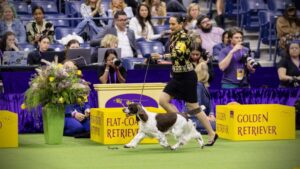
Clemencia Saavedra is the breeder behind Wallylama English Springer Spaniels. Read about the kennel’s beginnings, puppies, and more!

Linda Riedel is the breeder behind Ramblewood English Springer Spaniels. Read about the kennel’s beginnings, puppies, and more!
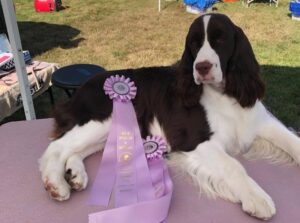
Judy Manley is the breeder behind Vistah English Springer Spaniels. Read about the kennel’s beginnings, the sires, the dams, and more!

Laureen Camisi is the breeder behind Sapphire English Springer Spaniels. Read about the kennel’s beginnings, the sires, the dams, and more!

Insights from an Owner Handler, Laureen Camisi. Read about her opinions on various topics about dog handling in the modern show ring.
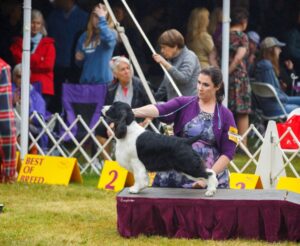
Insights from an Owner Handler, Dr. Kate Bremser. Read about her opinions on various topics about dog handling in the modern show ring.
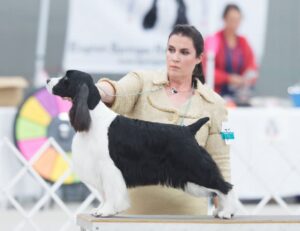
Interview with Owner Handler Dr. Kate Bremser. She shares her experiences as an Owner Handler in the world of purebred dogs and dog events.

"*" indicates required fields
Showsight Magazine–the world’s most influential purebred dog publication since 1992. Each issue reaches a global audience dedicated to preserving the history and health of purpose bred dogs. Filled with award-winning editorial focused on news and insights from the dog show community, top breeders, handlers, AKC Judges, and more!